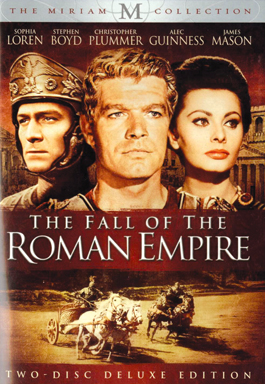home | metro silicon valley index | movies | current reviews | dvd review

Fall of the Roman Empire, Collector's Edition
Three/two discs; The Miriam Collection/Genius Products; $39.99/$24.95
By Michael S. Gant
No one could ever accuse producer Samuel Bronston of thinking small. After the Medieval Spanish epic El Cid, Bronston was inspired, according to a making-of documentary, by Gibbon's famous history to make The Fall of the Roman Empire (1964), a three-hour-plus spectacle filmed not in Panavision but Ultra-Panavision. Mixing history and fabrication, the film focuses on the death (in 180 C.E.) of the noble, peace-loving Marcus Aurelius (Alec Guinness in a wig and beard curlier than the Golden Fleece itself) and the reign of his corrupt son Commodus (Christopher Plummer) as the crucial moment at which Roman civilization started on its long, messy slide into orgies and group gropes. As the military tribune Livius, Stephen Boyd, picked because "he fit the costumes," upholds the old Roman virtues in counterpart to Commodus. Sophia Loren plays Commodus' sister, Lucilla, who tries to conjure up some chemistry with Boyd (again, as in El Cid, Loren, presumably hired for her statuesque figure, is covered up in yards of cloth). Anthony Quayle, James Mason, Mel Ferrer and Omar Sharif (as the king of the Armenians and looking silly in gold-plated hot pants) provide stentorian support. Best of all is Plummer, who plays Commodus with a mad glint in his eye and a sardonic grin, working the Senate like a savvy standup comedian who knows that when he slays his audience, he means it. Announcing plans for expanded conquests, he does a jolly little dance across a floor-tile map of the known world. Although director Anthony Mann sidesteps Commodus' more libertine excesses (according to Gibbon, "His hours were spent in a seraglio of three hundred beautiful women, and as many boys, of every rank, and of every province"—a debauch worthy of Pasolini), he does mount a terrific chariot race through a forest and stages many fine battle sequences (it helps to have legions of Spanish extras on call). On the downside, a scene in the camp of the conquered and newly rusticated barbarians (led by a wooly John Ireland) looks like a day at the Renaissance Faire, complete with clog-and-stick dancing. The real star of the film is the magnificent Roman Forum set, built outside of Madrid at what is purported to be a one-to-one scale. Say what you like about CGI, there is no substitute for this kind of old-fashioned craftsmanship. The sweeping crane shots of the masses before the Temple of Jupiter put us as close to the reality of Rome as a time machine. These are not facades but finished structures, complete with rich, color-banded interior walls. This boxed set matches the movie for grandiosity. The film, beautifully transferred, is backed with many fascinating documentaries and a series of Encyclopedia Britannica shorts that were made on the Forum set (a two-disc set skips the Britannica films, which are easily dispensed with), as well as a promotional booklet and postcard stills from the original release.
Send a letter to the editor about this story.
|
|
|
|
|
|